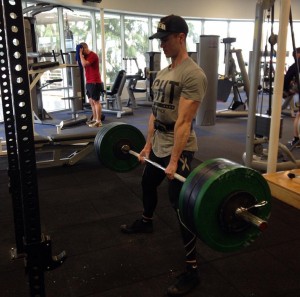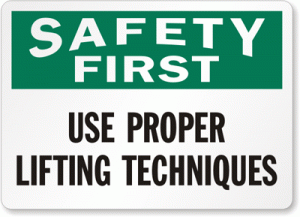How to use mental and physical cues to improve performance/technique and reduce risk of injuries
Completing 3 sets of squats for 12 reps can be a walk in the park, IF you aren’t executing each rep with perfect form.
If you aren’t executing each rep with perfect form then 3 sets of squats for 12 reps can also be absolute torture. Lower back pain, sore knees.. the list goes on.
In todays blog I want to share with you, a number of different mental and physical cues that you can run through in your head before each and every time you are lifting in the gym to assure you are performing the perfect reps. I’ve also listed a number of other exercises below each example that these cues also apply to.

BENCH PRESS
- Retract your shoulder blades so that they are pushing into the bench underneath you.
- Plant heels into the ground to allow for more power and drive.
- Imagine you are bending the bar. This will leave your elbows at around 45 degrees and protect the shoulder joint at the bottom of each rep.
*Dumbbell chest press, incline chest press, machine chest press.
PULL UPS
- Place all fingers, including your thumb over the bar.
- Imagine you are pulling your elbows down towards your lats instead of squeezing wth your hands to pull your body up. Both tips 1. and 2. remove all of the tension and activation from your forearms and biceps and send it to the lats which is ultimately what you are trying to target in this exercise.
- Brace your core and squeeze your glutes and quads. This prevents any swinging and allows you to keep your body straight.
*Lat pull down, chin ups, any pull down variations.
BACK SQUAT
- Squeeze the bar and tighten your upper back as if you were performing a lat pull down. This allows for a stronger foundation of support in the upper body and puts less stress through the core and lower back area.
- Toes slightly pointing outwards to allow for more activation of the glutes along with helping create a better range of movement for the hips. Along with a neutral position of the pelvis, this is your starting and finishing position which will result in proper flute and core activation.
-
Hips push back slightly before anything else moves. Whatever moves first will load first, meaning if the first movement you make is bending from your knees then don’t be surprised if you are feeling some sort of knee pain.
- Once the hips are pushed back now its time to bend from the knees and push them out as wide as you can, this will help open up the hips, activate the glutes and allow for a deeper and safer squat.
- Spread the floor with your feet. Think big toe, little toe, heel. Maintain an even distribution of weight through your feet.
- Once you’re at the bottom of the squat drive the hips forward and finish the rep with a neutral pelvis position with your glutes fully activated.
*All squat variations, lunge variations.
DEADLIFT
- Grip the bar as tight as possible.
- Depending on lifting stance either have your feet just inside shoulder width (conventional) or slightly outside shoulder width with toes pointing outwards (sumo).
- Spread the floor with your feet (big toe, little toe, heel) to fully activate the glutes and hamstrings before lifting from the ground.
- Position hips in a comfortable position which will allow you to apply force through your heels into the ground when lifting.
- Retract your shoulder blades and activate your lats which will pull the ‘slack’ out of the bar before lifting from the ground.
- Keep a neutral spine position, think 3 points of contact: Lower back > upper back > top of the skull. These 3 points should all be aligned. Imagine holding a tennis ball between your chest and your chins to make sure you’re head is in the right position. This means no looking up at the mirror when you’re at the bottom of the rep, this will cause a transfer of weight going forward and increases the risk of injury to your lower back.
- Hips and upper body MUST move at the same time, driving your hips forward and finishing in a neutral pelvis position just as you do with a squat. Apply as much force through the ground as possible when lifting the weight from the floor, really rip it off the ground.
- Make sure you aren’t leaning back too far at the top of the rep as this can cause a compression of the lower spine.
- The bar MUST move straight up in a straight line, a great way to make sure this happens is to keep your legs in contact with the bar the whole time.
ROMANIAN DEADLIFT
- Grip the bar as tight as possible.
- Keep upper back and core tight and shoulder blades retracted. Stating in a neutral pelvis position with glutes activated.
- Hips drop back slightly.
- Guide the bar down your legs while pushing hips up towards the roof.
- Maintain an even distribution of weight through your feet (big toe, little toe, heel) while letting your knees slightly push out to further activate the glutes.
- Once at the bottom of the rep, apply as much force through the ground as possible while exploding up to your neutral pelvis starting position with glutes fully activated.
- Keep a neutral spine position, think 3 points of contact: Lower back > upper back > top of the skull. These 3 points should all be aligned. Imagine holding a tennis ball between your chest and your chins to make sure you’re head is in the right position. This means no looking up at the mirror when you’re at the bottom of the rep, this will cause a transfer of weight going forward and increases the risk of injury to your lower back.
*Single leg arabesque.
SEATED ROW
- Chest out.
- Shoulders down and back.
- Core activated.
- Release your thumb and loosen your index finger. This means you will use your hand as a hook and mainly pull through the bottom of your hand.
- Initiate the movement through your elbows, focus on pull your elbows back and squeezing your shoulder blades. Again, this takes the pressure and activation away from your forearms and biceps and allows you to target the lats.
- When you bring the weight back out in front of your body on the eccentric phase of the lift, make sure you are keeping your shoulder blades retracted and not letting you shoulders internally rotate or round forward.
*All rowing variations.
HANGING LEG RAISE
- Before initiating the movement, squeeze your glutes to eliminate any momentum.
- Keep shoulder blades retracted when holding onto the bar.
- Think about curling/rolling your hips up towards your chest. To activate your lower abs you must curl/roll the hips towards your ribs, the opposite of a crunch which targets the upper area of the abs.
- Exhale on every contraction and control the eccentric (down) phase of each rep, coming to a complete stop at the bottom of each rep and starting the process all over again.
*Hanging knee raises + all lower ab exercises NEED a curl of the hips towards the chest.
BICEP CURL/TRICEP PRESS
- Chest out.
- Shoulders back.
- Elbows MUST stay tucked in, all movement comes from the elbow down to assure you are using the targeted muscle (bicep or tricep) to lift the weight and not the secondary muscles around the area.
- Full extend at the bottom of each rep, don’t stop halfway down/up. To get the most out of the exercise you need to fully stretch and contract on every rep.
*Rope press, dumbbell curls etc.
STANDING OVERHEAD PRESS
- Squeeze everything from the ground up (calves, quads/hamstrings, glutes and core) to give yourself a strong foundation from the ground up.
- Start with elbows and triceps facing towards the ground.
- Eliminate any arching of the back as you press above your head by squeezing the glutes and keeping your core tight.
- The bar path curves slightly as you need to tilt your head back when pressing up and finishing with your eyes forward and weight above your head.
CRUNCHES
- Eliminate all momentum and focus on curling your chest towards your hips.
- There’s no need to sit all of the way up as this simply uses the hip flexors and lower back while switching off the ab muscles.
- Exhale on every contraction and control the reps.
*All crunching variations.
PLANK
- Squeeze your glutes.
- Keep an even distribution of weight between your upper and lower body.
LATERAL RAISES
- Lift from the elbows.
- Your little finger should always be at the highest point along with your elbows.
- Hands should be slightly internally rotated.
Now obviously there are a tonne of other exercises I could discuss although the ones above are what I believe to be the most common exercises that are performed incorrectly.
The way you perform each rep of a given exercise can make or break the quality of the exercise and not too mention increase or decrease the likelihood of injury and rate of progress.
Give these mental and physical cues a try next time you perform any of these exercises and see whether to not you feel a difference compared to how you would usually perform the exercise.
Is your goal to lose fat? Or maybe build muscle?
Then check out my Ultimate guide to fat loss and Ultimate muscle building guide. They are both completely free and include everything you need to know about losing fat and building muscle the right way!



